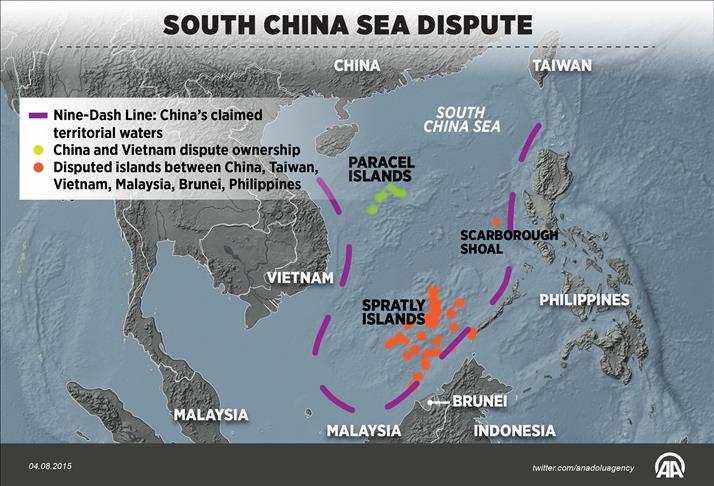
By Todd Crowell
TOKYO
A distinguished delegation of Philippine leaders, including Foreign Minister Albert del Rosario, wrapped up oral arguments in the case of the "Philippines v. China" before a panel of judges for the International Tribunal for the Law of the Sea in The Hague last month.
Manila had submitted a memorial seeking to nullify the "Nine-Dash Line" appearing on Chinese maps that makes it appear as if China is claiming the entire South China Sea, which Manila calls the West Philippine Sea.
Although representing only itself, the Philippines was in effect acting on behalf of other Southeast Asian nations with their own territorial disputes with Beijing in the area.
In fact, Vietnam submitted a kind of friends-of-the-court brief supporting Manila, while other nations, including Japan, sent observers.
The tribunal made a point of inviting Beijing to submit a counter-memorial justifying its position by mid-August, but Beijing has declined to defend itself in the tribunal and said that it would not abide by any decision.
It is the latest episode in the rapidly expanding conflict over this important body of water. Here is a guide to the issues and the countries involved:
What is the Nine-Dash Line?
It is a series of heavy purple dashes, nine of them, looping down from China, skirting the Philippines and reaching almost as far as Indonesia before looping back past Malaysia and Vietnam to China, which are shown on official maps.
They make it appear that China is claiming the entire South China Sea, not just the land features.
Has Beijing actually made such a claim?
Not officially, although it has been studiously ambiguous about what the maps mean and precisely where the so-called boundaries are located. No country in the world recognizes these dashes as a national boundary, which would bring into question other important bodies of water such as the Yellow Sea, the Black sea, and others.
Is the Nine-Dash Line something new?
No. It first appeared on official Chinese maps in 1947, under the Republic of China. Taiwan claims and occupies Itu Abu, which is the largest land feature in the South China Sea.
What else is in dispute?
There are two groups of land features in the South China Sea, the Paracels to the north and the Spratlys to the south. China and Vietnam dispute ownership of the Paracels, which China occupies and claims are an integral part of China. Six countries claim the islands, reefs and atolls in the Spratlys: China, Taiwan, Vietnam, Malaysia, Brunei and the Philippines. Vietnam and the Philippines occupy some of them.
Have the rival claims ever led to war?
Yes. In the 1974 "Battle of the Paracels" China ousted the then South Vietnam from the western Parcels in an action in which one Vietnamese frigate was sunk and several Chinese ships damaged with about 80 casualties. In 1988 China ousted Vietnam from Johnson Reef in a skirmish in which three Vietnamese vessels were sunk and 400 killed or wounded. Since then there have been numerous encounters short of actual war.
What is the latest point of contention?
Last year, China began a massive reclamation project on about half a dozen land features in the Spratlys, adding about 3,000 acres of artificial land and turning what were mere rocks barely above water at low tide into artificial islands large enough to host runways long enough to accommodate high-performance jet aircraft and naval docking.
What makes these projects new or unique?
In the 1990s several countries, including China built structures on some of these reefs in order to reinforce their claims, but these were small for the most part. The latest reclamation effort is many orders higher. For example, Beijing has turned Fiery Cross Reef, formerly a mere coral head sticking about a meter out of water, into the largest land feature in the Spratlys.
What does China plan to do with these artificial islands?
Beijing says that they are useful for weather stations and for providing shelter for commercial fishing boats and other civilian vessels during typhoons. Washington, Tokyo and others around the South China Sea area view them as a means of expanding China's military reach.
What is Washington's view, Tokyo's?
Neither the United States nor Japan claims any part of the South China Sea, but important interests are still involved. For the two, the main issue is free passage through these waters. Meanwhile Tokyo, which is currently loosening restrictions on its armed forces, is being drawn into the conflict by providing naval armaments to Vietnam and the Philippines.
U.S. and international security experts have also expressed concerns that it may only be a matter of time before China establishes an air defense identification zone over disputed waters in the South China Sea.
Why is the South China Sea important?
By some estimates, half of the world's sea-born commerce passes through the South China Sea. It is a vital lifeline to Japan, which imports about 80 percent of its petroleum needs from the Middle East, which pass through the waters in tankers. Beyond that are issues of potentially rich underwater minerals and fisheries.
What happens next?
Washington is currently debating whether to challenge China by flying aircraft directly over the islands as a way of asserting that the islands are not Chinese sovereign territory. The United States Navy has already conducted air patrols in the vicinity of the islands while being careful to not violate their 12 nautical mile limit (which the U.S. does not recognize).
At the moment, Washington seems to be lining up support. Japan's navy chief Adm. Tomohisa Takei said the South China Sea must be "free and open" to all at a conference in Washington. Amy Searight, a deputy assistant secretary of defense, is working to have European nations to be more forceful on the issue.
Anadolu Agency website contains only a portion of the news stories offered to subscribers in the AA News Broadcasting System (HAS), and in summarized form. Please contact us for subscription options.

